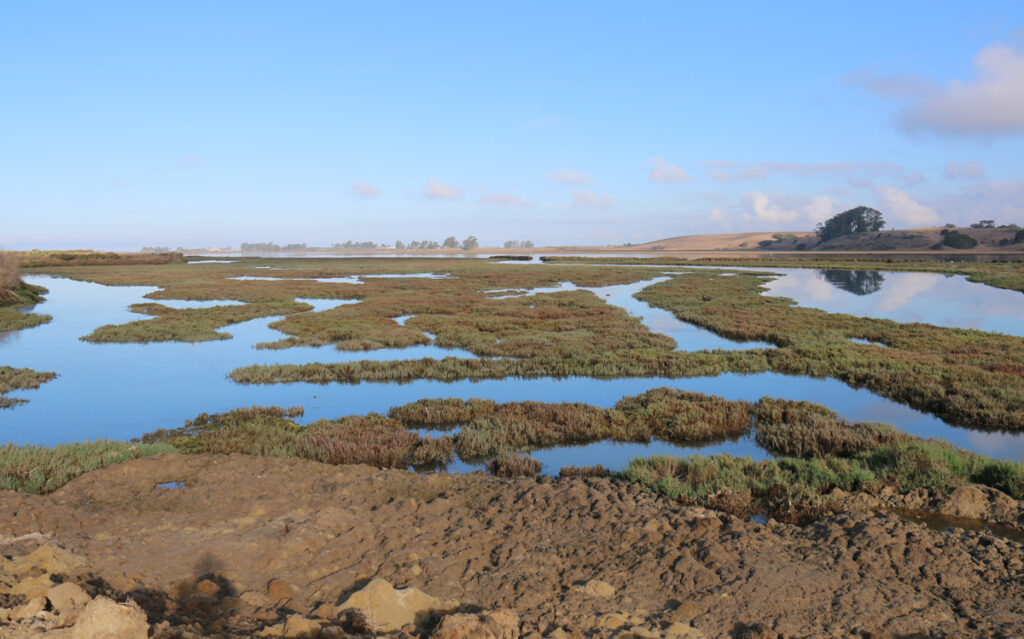Sea otters, once hunted to near extinction, are staging a comeback in California. Their return has revealed the incredible positive effects these furry apex predators can have on the state’s coastal ecosystems, including kelp forests and seagrass meadows. Now, there’s another coastal ecosystem to add to that list, one that plays an important role in bank stabilization, water filtration, and carbon storage: the salt marsh.
In a new study in Nature, researchers found that sea otters have reduced bank erosion rates by 69% in Elkhorn Slough, a coastal wetland south of San Francisco, in the decades since their return to the estuary. Their big effect is due to their big appetites—the Elkhorn Slough salt marsh has been eroding, in part, because of root-munching shore crabs that burrow into the soil and destabilize the banks. A single otter can easily eat dozens of these destructive crustaceans each day. (The predator needs to chow down roughly a quarter of its body weight daily.) When otters move in, they clear out many of the crabs, and the salt marshes benefit.

“The thing with sea otters is that because they eat so much, wherever they go, you should expect to see an effect,” said Brent Hughes, a biologist at Sonoma State University and lead author of the study. This study provides evidence that the return of apex predators should be considered alongside physical and chemical factors such as hydrology, nutrient enrichment, and sea level rise when trying to understand the causes of bank erosion, he said.
An Otterly Dramatic Comeback
In the early 1900s, California sea otters were driven to near extinction by the international fur trade. Since then, reintroduction efforts and laws protecting otters have enabled them to recolonize parts of their former range. Individual otters began popping up in Elkhorn Slough in the 1980s after decades of absence, but it wasn’t until the late 2000s that researchers noticed them venturing deeper into the estuary’s tidal creeks—somewhere they’d never been observed before.
At the time, Hughes was studying otters’ impacts on seagrass meadows in the area. “It was just because we were already following them around that we noticed them using the salt marshes,” he said. “That was just a huge discovery on its own.”
He and his colleagues knew that the marshes were suffering from erosion partially driven by the presence of root-eating shore crabs, whose abundant burrows turned the banks into a craterous “moonscape,” Hughes said. So, they wondered, could the return of the hungry otters be affecting erosion rates on the marsh?
“You could actually hear the crabs moving around the marsh and making this percolating sound.” But now, “it’s silence.”
Hughes, a plant biologist by training, teamed up with salt marsh experts and geomorphologists to tackle this question. The team used both historical observations and experimental data in their analysis. The historical data showed a correlation between greater otter numbers and lower erosion rates in the marsh—even as physical stressors such as sea level rise and tidal scour increased.
The team also ran a 3-year experiment using cages to block otters out of several tidal creeks while allowing them to continue to use others. The results were dramatic: Where otters were excluded, there were more crabs, more burrows, and less soil mass.
“It’s refreshing to see evidence of conservation paying off in a clearly measurable way,” said Alicia Wilson, a hydrologist with the University of South Carolina who was not involved with the study.
Hughes, who remembers the salt marsh before otter colonization, said that the landscape even sounded different decades ago. “You could actually hear the crabs moving around the marsh and making this percolating sound,” Hughes said. But now, “it’s silence.”
The Importance of Predators to Coastal Ecosystems
Finding a new way to stabilize salt marshes—and fast—is important because these ecosystems are declining dramatically worldwide because of sea level rise and coastal development. Their hydrology and physical characteristics are notoriously challenging to recreate, so once they’re gone, they’re often gone for good. Their benefits disappear with them. Salt marshes are important stopover points and breeding sites for migratory shorebirds. Their soils and grasses also act as sponges for storm surges, and they are great at storing carbon—when they’re healthy.
“If top predators like the sea otter reduce the density of crab burrows, that means they could also increase carbon storage in salt marsh sediments.”
Recent studies have shown that crab burrows, in addition to destabilizing marshes, might inhibit their ability to store carbon by increasing biodegradation even when the marshes are still intact. In light of that, the implications of the new study are “really interesting,” Wilson said. “If top predators like the sea otter reduce the density of crab burrows, that means they could also increase carbon storage in salt marsh sediments.”
Previous studies have focused on the physical forces that drive salt marsh stability and loss, but many coastal ecosystems around the world have lost apex predators—not only otters but also larger carnivores such as wolves, bears, and crocodiles. This study shows that restoring them could be a powerful way to help these imperiled ecosystems endure for many years to come.
To that end, Hughes has now turned his attention to coastal regions of California where otters have not yet returned. He hopes this and future studies can help inform reintroduction plans for the small, but mighty, sea otter.
—Rachel Fritts (@rachel_fritts), Science Writer
This news article is included in our ENGAGE resource for educators seeking science news for their classroom lessons. Browse all ENGAGE articles, and share with your fellow educators how you integrated the article into an activity in the comments section below.


